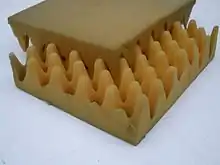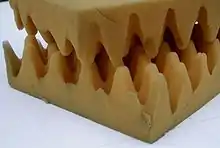

In physics (specifically tribology), superlubricity is a regime of motion in which friction vanishes or very nearly vanishes. However, a "vanishing" friction level is not clear, which makes the term vague. As an ad hoc definition, a kinetic coefficient of friction less than 0.01 can be adopted.[1] This definition also requires further discussion and clarification.
Superlubricity may occur when two crystalline surfaces slide over each other in dry incommensurate contact. This effect, also called structural lubricity, was suggested in 1991 and verified with great accuracy between two graphite surfaces in 2004.[2] The atoms in graphite are oriented in a hexagonal manner and form an atomic hill-and-valley landscape, which looks like an egg-crate. When the two graphite surfaces are in registry (every 60 degrees), the friction force is high. When the two surfaces are rotated out of registry, the friction is greatly reduced. This is like two egg-crates which can slide over each other more easily when they are "twisted" with respect to each other.
Observation of superlubricity in microscale graphite structures was reported in 2012,[3] by shearing a square graphite mesa a few micrometers across, and observing the self-retraction of the sheared layer. Such effects were also theoretically described[4] for a model of graphene and nickel layers. This observation, which is reproducible even under ambient conditions, shifts interest in superlubricity from a primarily academic topic, accessible only under highly idealized conditions, to one with practical implications for micro and nanomechanical devices.[5]
A state of ultralow friction can also be achieved when a sharp tip slides over a flat surface and the applied load is below a certain threshold. Such a "superlubric" threshold depends on the tip-surface interaction and the stiffness of the materials in contact, as described by the Tomlinson model.[6] The threshold can be significantly increased by exciting the sliding system at its resonance frequency, which suggests a practical way to limit wear in nanoelectromechanical systems.[7]
Superlubricity was also observed between a gold AFM tip and Teflon substrate due to repulsive Van der Waals forces and hydrogen-bonded layer formed by glycerol on the steel surfaces. Formation of the hydrogen-bonded layer was also shown to lead to superlubricity between quartz glass surfaces lubricated by biological liquid obtained from mucilage of Brasenia schreberi. Other mechanisms of superlubricity may include:[8] (a) Thermodynamic repulsion due to a layer of free or grafted macromolecules between the bodies so that the entropy of the intermediate layer decreases at small distances due to stronger confinement; (b) Electrical repulsion due to external electrical voltage; (c) Repulsion due to electrical double layer; (d) Repulsion due to thermal fluctuations.[9]
The similarity of the term superlubricity with terms such as superconductivity and superfluidity is misleading; other energy dissipation mechanisms can lead to a finite (normally small) friction force. Superlubricity is more analogous to phenomena such as superelasticity, in which substances such as Nitinol have very low, but nonzero, elastic moduli; supercooling, in which substances remain liquid until a lower-than-normal temperature; super black, which reflects very little light; giant magnetoresistance, in which very large but finite magnetoresistance effects are observed in alternating nonmagnetic and ferromagnetic layers; superhard materials, which are diamond or nearly as hard as diamond; and superlensing, which have a resolution which, while finer than the diffraction limit, is still finite.
Superlubricity at the macroscale
In 2015, a team led by Dr. Anirudha Sumant at the Argonne National Laboratory have been able to experimentally demonstrate superlubricity at true microscale for the first time.[10] The detailed experimental investigations were supported by sophisticated computational studies. Argonne scientists used Mira [supercomputer] simulating up to 1.2 million atoms for dry environments and up to 10 million atoms for humid environments.[10] The researchers used the LAMMPS (Large-scale Atomic/Molecular Massively Parallel Simulator) code to carry out the computationally demanding reactive molecular dynamics simulations. This team optimized LAMMPS and its implementation of ReaxFF by adding OpenMP threading, replacing MPI point-to-point communication with MPI collectives in key algorithms, and leveraging MPI I/O. Altogether, these enhancements allowed the code to perform twice as fast as before. Dr. Sumant's research team has already acquired three US patents on superlubricity and more are in the process, which could potentially be used for applications in dry environments, such as computer hard drives, wind turbine gears, and mechanical rotating seals for microelectromechanical and nanoelectromechanical systems. Dr. Sumant gave a TEDX talk on Superlubricity.[11]
See also
References
- ↑ Müser, Martin H. (2015-01-01). "Theoretical Studies of Superlubricity". In Gnecco, Enrico; Meyer, Ernst (eds.). Fundamentals of Friction and Wear on the Nanoscale. NanoScience and Technology. Springer International Publishing. pp. 209–232. doi:10.1007/978-3-319-10560-4_11. ISBN 9783319105598.
- ↑ Dienwiebel, Martin; Verhoeven, Gertjan S.; Pradeep, Namboodiri; Frenken, Joost W. M.; Heimberg, Jennifer A.; Zandbergen, Henny W. (2004-03-24). "Superlubricity of Graphite" (PDF). Physical Review Letters. American Physical Society (APS). 92 (12): 126101. Bibcode:2004PhRvL..92l6101D. doi:10.1103/physrevlett.92.126101. ISSN 0031-9007. PMID 15089689.
- ↑ Liu, Ze; Yang, Jiarui; Grey, Francois; Liu, Jefferson Zhe; Liu, Yilun; Wang, Yibing; Yang, Yanlian; Cheng, Yao; Zheng, Quanshui (2012-05-15). "Observation of Microscale Superlubricity in Graphite". Physical Review Letters. American Physical Society (APS). 108 (20): 205503. arXiv:1104.3320. Bibcode:2012PhRvL.108t5503L. doi:10.1103/physrevlett.108.205503. ISSN 0031-9007. PMID 23003154. S2CID 119192523.
- ↑ Superlubricity through graphene multilayers between Ni(111) surfaces
- ↑ Graphite super lube works at micron scale Philip Robinson, Chemistry World, 28 May 2012
- ↑ Socoliuc, A.; Bennewitz, R.; Gnecco, E.; Meyer, E. (2004-04-01). "Transition from Stick-Slip to Continuous Sliding in Atomic Friction: Entering a New Regime of Ultralow Friction". Physical Review Letters. American Physical Society (APS). 92 (13): 134301. Bibcode:2004PhRvL..92m4301S. doi:10.1103/physrevlett.92.134301. ISSN 0031-9007. PMID 15089616.
- ↑ Socoliuc, Anisoara; Gnecco, Enrico; Maier, Sabine; Pfeiffer, Oliver; Baratoff, Alexis; Bennewitz, Roland; Meyer, Ernst (2006-07-14). "Atomic-Scale Control of Friction by Actuation of Nanometer-Sized Contacts". Science. American Association for the Advancement of Science (AAAS). 313 (5784): 207–210. Bibcode:2006Sci...313..207S. doi:10.1126/science.1125874. ISSN 0036-8075. PMID 16840695. S2CID 43269213.
- ↑ Popov, Valentin L. (2020). "Contacts With Negative Work of "Adhesion" and Superlubricity". Frontiers in Mechanical Engineering. 5. doi:10.3389/fmech.2019.00073.
- ↑ Zhou, Yunong; Wang, Anle; Müser, Martin H. (2019). "How Thermal Fluctuations Affect Hard-Wall Repulsion and Thereby Hertzian Contact Mechanics". Frontiers in Mechanical Engineering. 5. doi:10.3389/fmech.2019.00067.
- 1 2 Berman, Diana; Deshmukh, Sanket A.; Sankaranarayanan, Subramanian K. R. S.; Erdemir, Ali; Sumant, Anirudha V. (2015-06-05). "Macroscale superlubricity enabled by graphene nanoscroll formation". Science. 348 (6239): 1118–1122. doi:10.1126/science.1262024. ISSN 0036-8075.
- ↑ "Superlubricity-near zero friction from nanodiamonds | Anirudha Sumant | TEDxNaperville". YouTube. 2018-11-30. Retrieved 2022-04-01.